Your cart is empty
STORY BY Darryl Pace
NORWAY
Imagine the feeling you had as a child waking up on Christmas Day. Sleep failed you, and now it’s 4 a.m. You’re wide awake — the excitement, the unknown, and a bit of magic sprinkled in. This is how September 25th, the opening day of Norway’s moose hunting season, was described to me — a date talked about throughout the year, with time booked off of work and logistics planned at the earliest opportunity.
It’s September 23rd, and I find myself on a plane, heading to the cultural mecca of hunting in Scandinavia to meet my good friend Lise Ailin Lorentzen. As I look down, the snow-capped mountains of Norway thrust skyward from the sprawling fjords in the true character of the West Coast. A country steeped in history, Norway conjures images of historic Viking raiders and a vast, uninhabited wilderness punctuated with only the occasional wooden cabin. The landscape below me is in stark contrast to the mild temperatures and lush greens of Scotland I left behind. I am destined for the small town of Fauske, where Lise lives. Here, they endure 24 hours of darkness for almost a month straight, and 24 hours of daylight for three months of the year. It’s a place where you can truly experience the midnight sun.
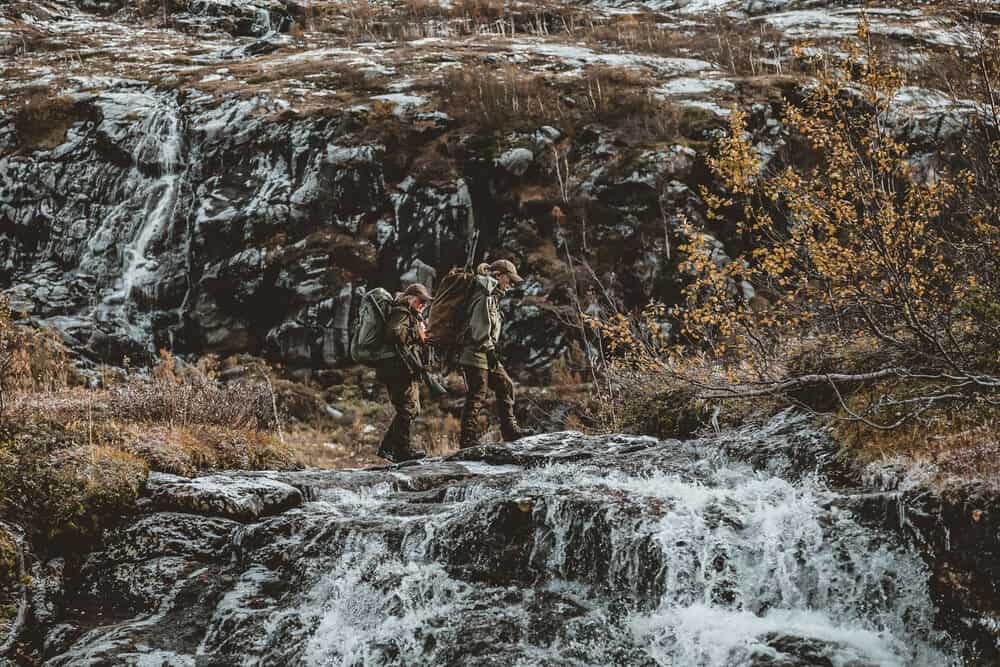
Despite the harsh, lengthy winters, the locals are as friendly as they come; if you like the outdoors and hunting, an open door, good company and a bed are never far away. For many Norwegians, hunting is a way of life, with skills passed down through the generations. This is true in a number of other European nations, but the Nordic countries have some of the strongest modern leanings. Almost 5% of the Norwegian population hunts in some capacity, and with only four million people, there is plenty of wild space to do so. Even more interesting is the vigorous growth in the numbers of female hunters. Between 2014 and 2019, there was a 22.1% increase in registration and a 21% increase in females buying a hunting license. In contrast, the statistics for males show a stagnation in registered hunters.
I met Lise, an avid hunter, while on a filming project in Alesund in the northwest of Norway three years ago. I recall a tiny blonde woman bouncing over to my brother and I who, in true Norwegian style, immediately apologized for her bad English with perfect pronunciation. We later found out that it had been 15 years since she’d last spoken in anything other than Norwegian. It was during this trip that our friendship formed, where Lise’s determination and strength made her an invaluable member of the filmmaking team. Her attitude was simple: if you are going up that mountain, then I am going with you, and I can carry as much equipment as everyone else. She had a quick comeback to anyone who mentioned her size: “They build them small and tough in the north — real Viking women,” was the standard reply. This statement was well and truly proven when I hurt my knee coming down a particularly steep section one day. Lise didn’t hesitate loading up my equipment, which easily weighed as much as she did, on her back. I’m sure that descent is now recalled as both emotionally and physically painful, but at the time, she did not complain nor show signs of discomfort.
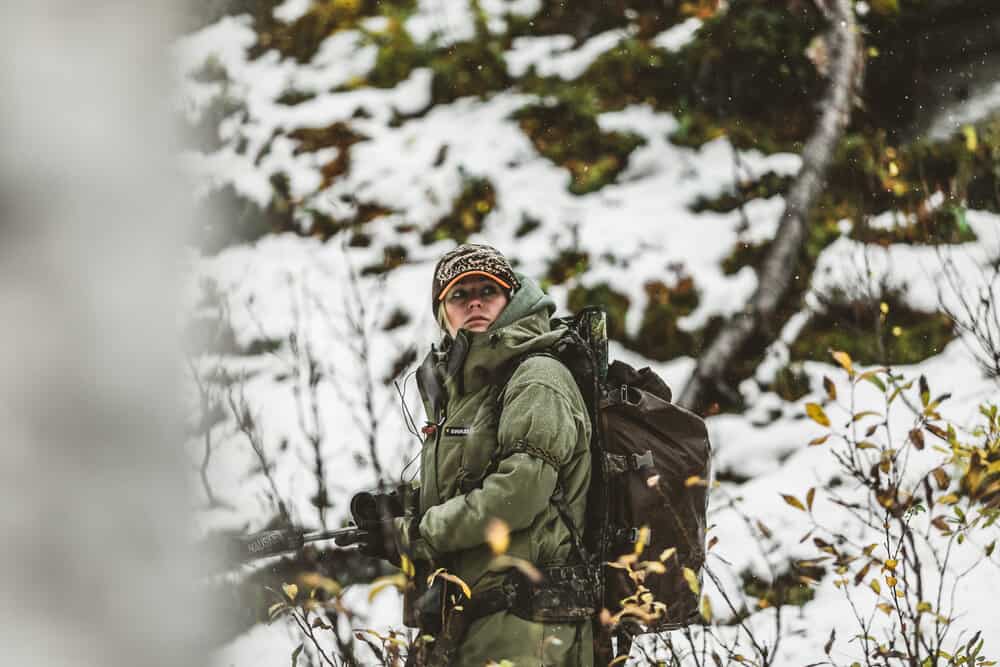
In the three years that followed, Lise and I continued to stay in contact, with her coming to Scotland several times since to experience hunting in my homeland. As well as working together on two further projects in Norway, we remarkably crossed paths in Svalbard by pure coincidence, both being in the Arctic Circle for separate projects. However, the catalyst for this trip came when I visited Lise and her parents with my wife for a short holiday to experience a slice of Norwegian winter. It was there, in her parents’ cabin, whilst feasting on Møsbrøm-lefse, a cheese dish only made in the North, as well as the finest Norwegian cod caught by her father, that they persuaded me to come back later in the year for the start of the moose hunting season. As you can imagine, I did not need much convincing.
Fast forward six months, and I’m back in Norway, quickly descending into Bodo; the mountains are so tall they are now high above the plane as we land, the sun slowly setting behind them. I’m collected by an ever-smiling Lise, and we waste no time in heading to her parents’, where the hunting ground is located in Saltdal. As we pull up to the garage, I see a group of eight people inside — men and women enjoying a beer, their kids running around playing. I notice the majority of the people are all standing around a map. They were the landowners in the area, their properties all interconnecting across the mountain range, making for one large, continuous hunting area. Moose hunting is much more of a community event than anything I’ve seen before, and it makes sense; these animals are constantly on the move and in a day will cross between many different properties. This, paired with the government system of issuing tags for each area as opposed to an individual, means that locals need to work together to be successful. This year, the government issued four tags for our area: a calf, two cows and a bull. Some may regard this as restrictive for an area of 20,000 acres, but time is against you in this part of the world. The snow comes quickly, and due to the elevation of these mountains, the moose could be driven to lower ground quickly, losing all chances of filling the freezer.
“Time is against you in this part of the world. The snow comes quickly, and due to the elevation of these mountains, the moose could be driven to lower ground quickly, losing all chances of filling the freezer.”
As I listen to the planning and watch marks being made on the map, I can see a finely tuned, military-style operation forming, with the last crucial details being made before a 5 a.m. start the following day.
I am woken up sharp by Lise and her mother, Ann Kristine, both buzzing, anticipation thick in the air. Greeted with a typical Norwegian breakfast of coffee, bread and as much meat as you can possibly eat, we are soon on our way, walking steadily toward the mountains. I am still half asleep (I don’t do mornings), with Lise and Ann Kristine walking next to me. With every footstep comes the distinctive, carrying crunch of snow. It’s been falling all night, and this complicates matters. Everyone is due to start climbing the mountains, but the sky is still thick with snow. There’s a concern that the moose could be much farther down than anticipated the night before, so we head for a lower spot to set up and spy into the peaks. Getting comfortable, I’m messing around with a lens to start my day’s documenting when I hear a soft snapping behind me. I turn to the sound, immediately eyeballing the looming figure of a large bull moose, only ten meters away, staring directly at me from between the trees. As I try to get Lise’s attention, still scrambling to put my camera together, the moose disappears into the undergrowth. A chance missed for us might mean an opportunity for one of the other hunters. I’ll have to be more alert; for such large animals, they are astonishingly silent.
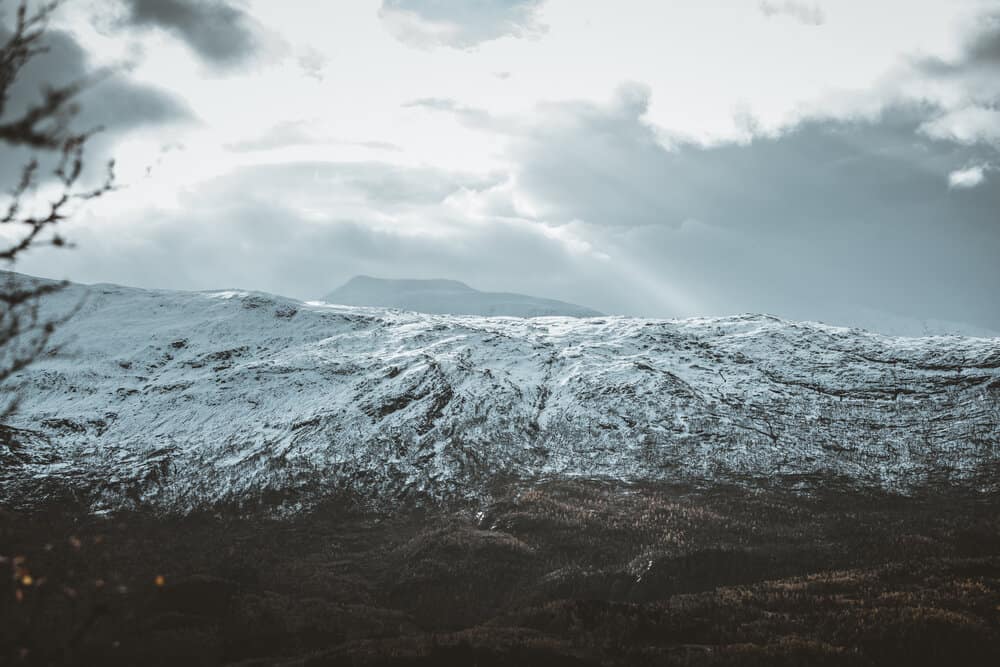
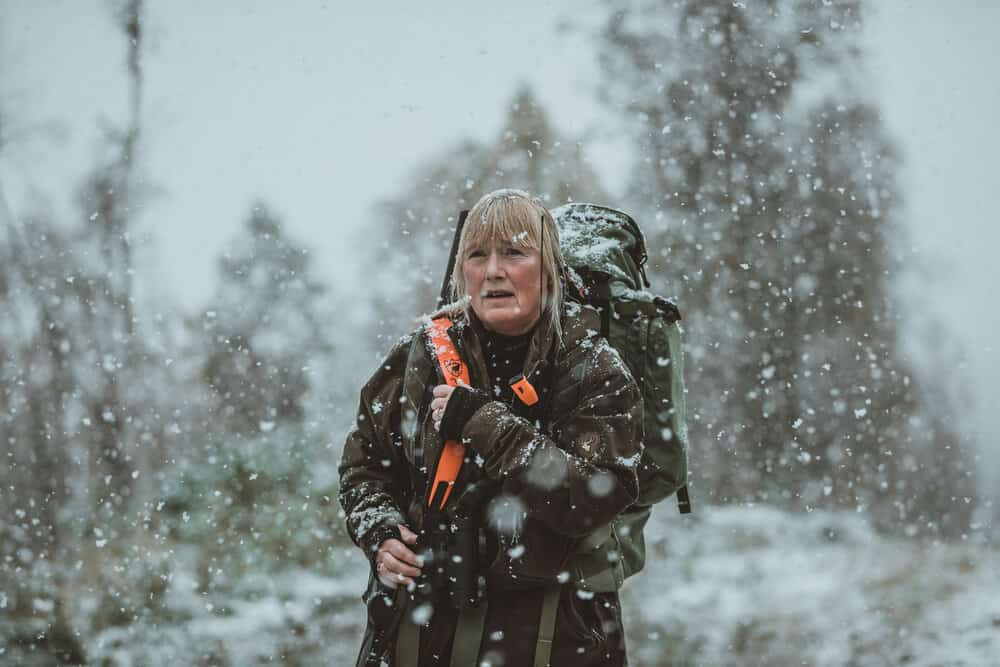
As the snow stops, Lise and I proceed up the mountain; we all have our specific areas to cover. Legs burning as the terrain steepens, we are almost at our destination when she gets a call over the radio. We’re informed that a moose has been shot, but they’re having trouble finding it. It’s on the boundary of the land, quite far away from us, but we proceed around the mountain on the off-chance it’s moving our way. With Lise in a superhuman, power-walking sprint, we cover ground quickly. In no time, we hear the calls of the moose dogs and follow on. Rapid and constant barking indicates we are close. Holding our position, we wait as the other hunters maneuver to provide better coverage of the area. Priority one is ensuring the animal is down as efficiently and ethically as possible.
A moose is a big animal — much bigger, actually, than I ever imagined. Standing over two meters tall, an adult male can weigh up to 700 kg (over 1500 lbs). Swiveling my head slowly to try to catch even the tiniest of sounds, I catch sight of a moose lumbering between the trees in front of us, disregarding the dog barking around it. Lise stands up, leaning against a tree for a steadier rest. It’s going to be a difficult shot, but I have no doubt in her skill; she knows the terrain and the animals, and I have seen her take challenging shots in Scotland. The moose continues its slow, steady walk upward, but quickly becomes obscured by thick trees. No shot. We wait for further instructions over the radio. Not even a minute passes, and we hear the distinct crack of a rifle; someone else was in a better position to get the shot.
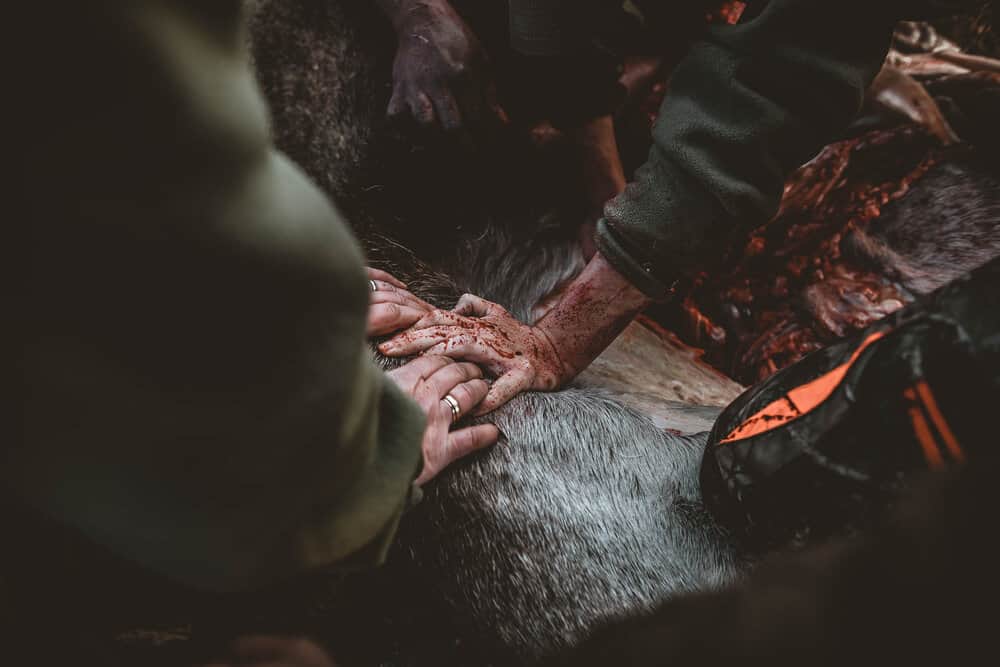
As we approach, a number of hunters have already begun processing the fallen carcass. This is when the real work starts. Lise rolls up her sleeves, kneels down next to Ingvild, a hunter I met the previous evening and the owner of the moose dog. With a seasoned and well-practiced group, short work is made of the initial preparation, and after the animal is gutted (or gralloched, as we say in Scotland) they manage to weave an ATV up the mountain to bring the beast down the valley. The ATV is a rare and lucky convenience made possible by an old forestry track nearby. What comes next is more hard graft, but also a chance to celebrate.
By the time we arrive at the double garage next to Lise’s parents cabin, a dozen people are already waiting to help hoist the moose up and begin the skinning and cleaning process. As three people work on the carcass, kids are given legs to practice their skinning skills. Around us, the sound of beers opening marks the beginning of a growing celebratory atmosphere. It has been a successful opening day of the season, but quickly the discussion shifts to focus on plans for the days ahead. There are still three tags to fill.
Over the following two days, the weather becomes colder, and intermittent snow showers make conditions more challenging.
We find ourselves venturing higher and higher into the mountain range, to places known to shelter moose in this kind of weather. I am fully aware that every step I take higher and further away from the cabins means potentially having to get a moose back down on foot, and at this point, I’m not sure how this will even be achievable with the severity of the terrain.
On my penultimate day, I head out early into the mountains with Ann Kristin and Lise’s husband, who has newly discovered hunting. We’re heading to the farthest boundary of their land, which is in a glacial bowl at the highest point of the mountain range. This will be three to four hours of steady walking, but our final destination is the ideal place for moose to seek shelter. My already tired legs begin to falter as I try to keep up with Ann Kristine. After climbing over what seems like the 100th false summit, she turns to me. “Why would anyone be against hunting? Look how hard we have to work to get one animal, and that animal has lived a happy and free life.” She starts to walk again and then pauses, looking back, taking in the view. “Who would not want to be up here looking at this every day?”
I couldn’t agree more with both statements. Ann Kristine’s hunting heritage came from her grandfather, who brought her up making little differentiation between the roles of men and women. She, like the men, would hunt. This was not common at that time; however, he didn’t care if you were a boy or a girl — you did everything the same, and in hindsight, his view of the world was progressive. It’s clear that the same way of thinking has been instilled in her daughter, Lise.
After just over three hours of speed hiking and scrambling, we finally get into position. We were told over the radio by Lise’s cousin, Espen — who hiked in the dark to get a vantage point of the whole bowl — that he could see at least one moose below us. I can hear the radio crackle as a handful of other hunters also find their final location. Now it’s a waiting game while designated people slowly push the moose toward us.
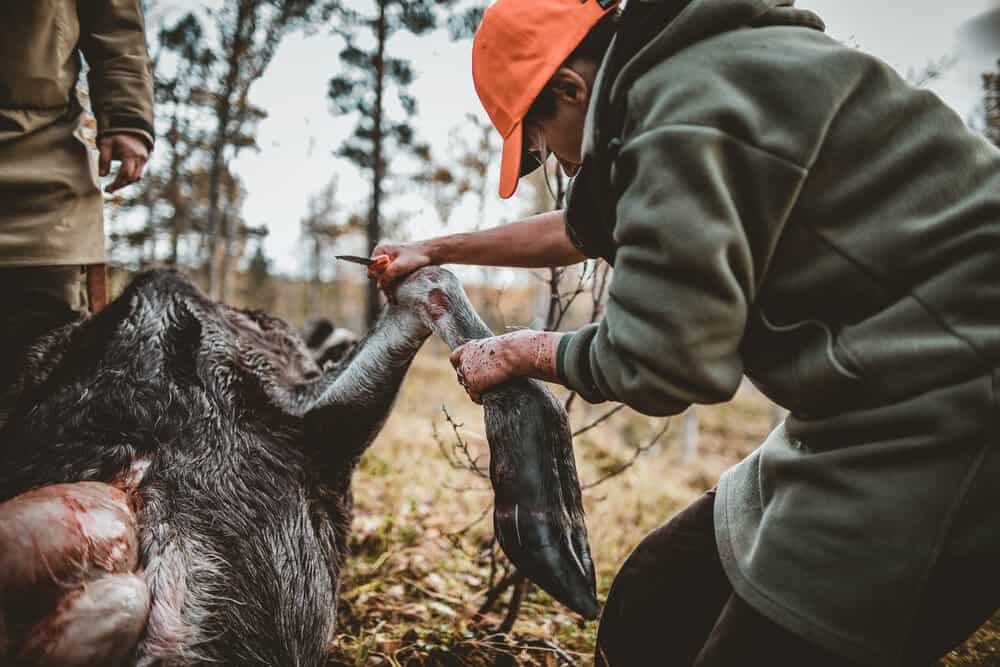
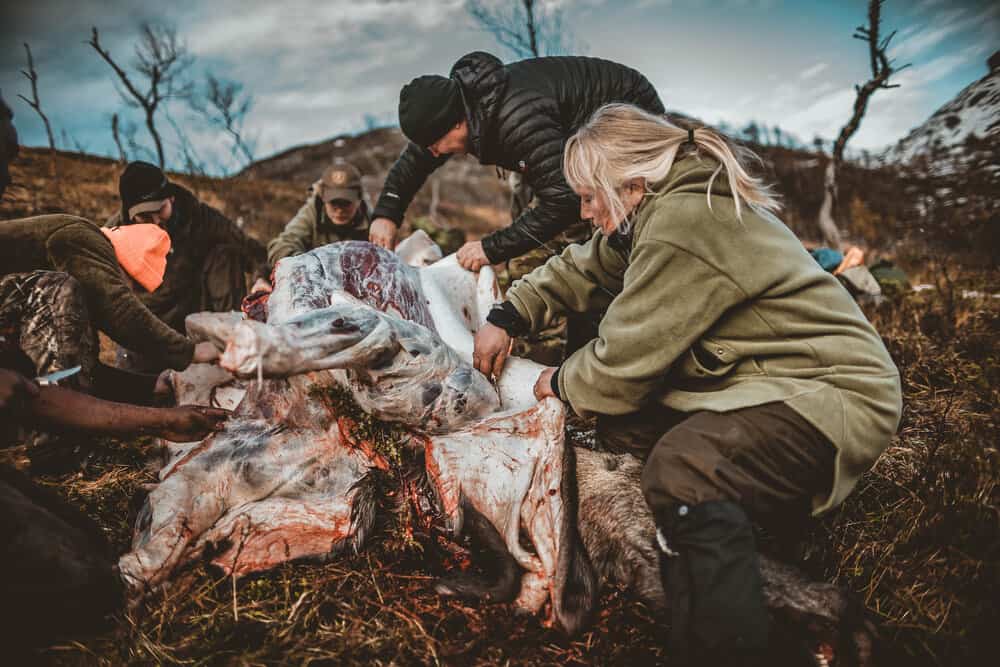
After a static hour observing, my feet are frozen blocks. I am unusually underprepared for the cold, and it would seem Christian, Lise’s husband, is in the same boat. I mention my cold feet to Ann Kristine as a passing comment, and before I know it, she has a small fire lit and hot chocolate poured. With feet suitably defrosted, we settle back down to spying, and after about an hour, I start to give up hope of seeing anything. Just as thoughts of another hot chocolate cross my mind, a moose comes trotting at speed through the stunted, wind-swept trees and into our clearing. It’s moving with purpose. For Ann Kristin, this is a calculated, practiced process. Quickly, she adjusts her seating position, following the moose through the scope. Shouting a call, the brief break in its stride is all that’s required. Crack. A handful of paces uphill and the moose stumbles, falling to the ground. Those are its final steps on this earth. It lies quiet and motionless.
“We approach the fallen giant, taking our time to appreciate the gravity of our part in this story. Ann Kristine poignantly highlights, “You are not human if you do not think taking a life like this is sad.” ”
We approach the fallen giant, taking our time to appreciate the gravity of our part in this story. Ann Kristine poignantly highlights, “You are not human if you do not think taking a life like this is sad.” She bends down and strokes the massive animal; I am staggered by the size of it. Easily 500 kg (1100 lbs), it is the biggest animal I have seen hunted. How are we getting this off this mountain? We have crossed multiple wooden bridges, river crossings, and terrain so steep it required all four limbs to make contact with the moist ground to avoid sliding back down the mountain.
As the other hunters arrive, including Lise’s father, a plan is formulated. Due to the lateness of the day, we will process the animal on location, cutting it into manageable pieces before hanging it up in a tree. This will deter other wildlife from an easy meal. The following day, we will come back with more light on our side. Watching the hunters gather, I spot someone dressed in bright red walking toward us through the treeline — a man named Gilbert. The vivid red that first caught my eye is his traditional Maasai shuka. Originally from Kenya, he settled with his family in this remote part of Norway. I ask what drew him to hunting in Norway, a polar opposite environment to the dry, arid land of his home country. His answer is simple: “Do you know how expensive beef is in the North? Very expensive. This is some of the best meat you can get on your doorstep.” He’s correct, with store-bought beef costing almost $28 per kg. By comparison, in the UK, it costs around $8 per kg. Although wages in Norway are generally higher, getting valuable protein like this is a real win for rural families such as Lise’s and Gilbert’s.
With the night falling quickly upon us, the carcass is quickly processed using the hide as a makeshift table to avoid any contamination. Massive pieces of meat are hung up between the trees, acting as a temporary outdoor larder. Little is wasted: heart, lungs, liver, all straight into bags, with the bulk of the big cuts being broken down once off the mountain. Interestingly, the jawbone is removed to be sent to a government laboratory for age verification and DNA testing. This has been done since the 1970s, when a new strategy for forestry and game management was put in place, including gender- and age-specific hunting. It has allowed for a very stable harvest over the last few decades, with accurate data allowing for better population control, delivering stocking densities in harmony with land management goals and ecological impacts. Today, the national harvest is around 35,000 animals.
I have to laugh as Lise walks to a leg of the moose almost the same size as her. It looks like a scene from The Flintstones. Before I know it, the entire moose is safely in the tree, and we are back on our way down the mountain, just as darkness envelops the landscape. The only break in the blackness comes from the tiny lights of cabins far below us, flickering like candles between the trees.
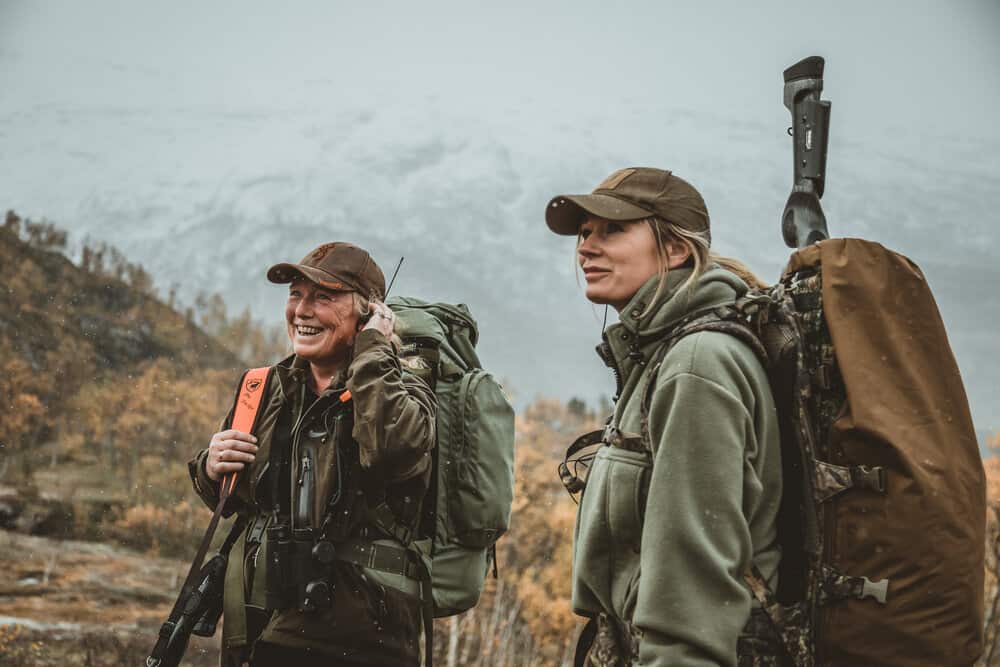
The following morning, we climb back up the mountain just as the sun begins to rise. Lise and her mother and father, all laden with large backpacks, retrace the path back to where the moose fell. We aren’t the first to set off, and are soon passed by locals already bearing the weight of full packs, knees creaking, heading back down. To my surprise, none of these people were involved in the hunt yesterday, but they were clearly happy to lend a hand. By the tree are some familiar faces packing meat into bags. Tackling a section of rib cage, Lise enlists a helping hand to maneuver it into the pack on her back. More people arrive, including one hunter’s extraordinarily pregnant wife; everyone chips in, it seems. The way down is grueling. The sheer steepness of some sections is terrifying, especially with 30–40kg of additional carriage. I watch as Lise and Ann Kristine pick their way through the rocks, packs almost the same weight as themselves. I look past them to witness a trail of ant-sized people zig-zagging down the mountain range toward the larder, an entire community of people rallying to help. As we get to the bottom, Lise falls on her front, sharply slamming the ground and forcing an expletive from her small frame. “When we head out again later today, let’s shoot it a bit closer to home.”
Meat from both animals will soon be portioned out, the amount determined by who made the shot and how much land you own. I see Lise and Ann Kristin getting their rifles and packs ready to head back up the mountain. They really waste no time here. To my shame, my legs are wrecked, and I am somewhat reluctant to follow, although I only carried camera equipment up and down. I watch as Lise and her mum start slowly ambling up a track behind the house. Walking side by side, it is not your typical mother-daughter day out, but I know Lise would not have it any other way. They build them tough in the North. Real Viking women.
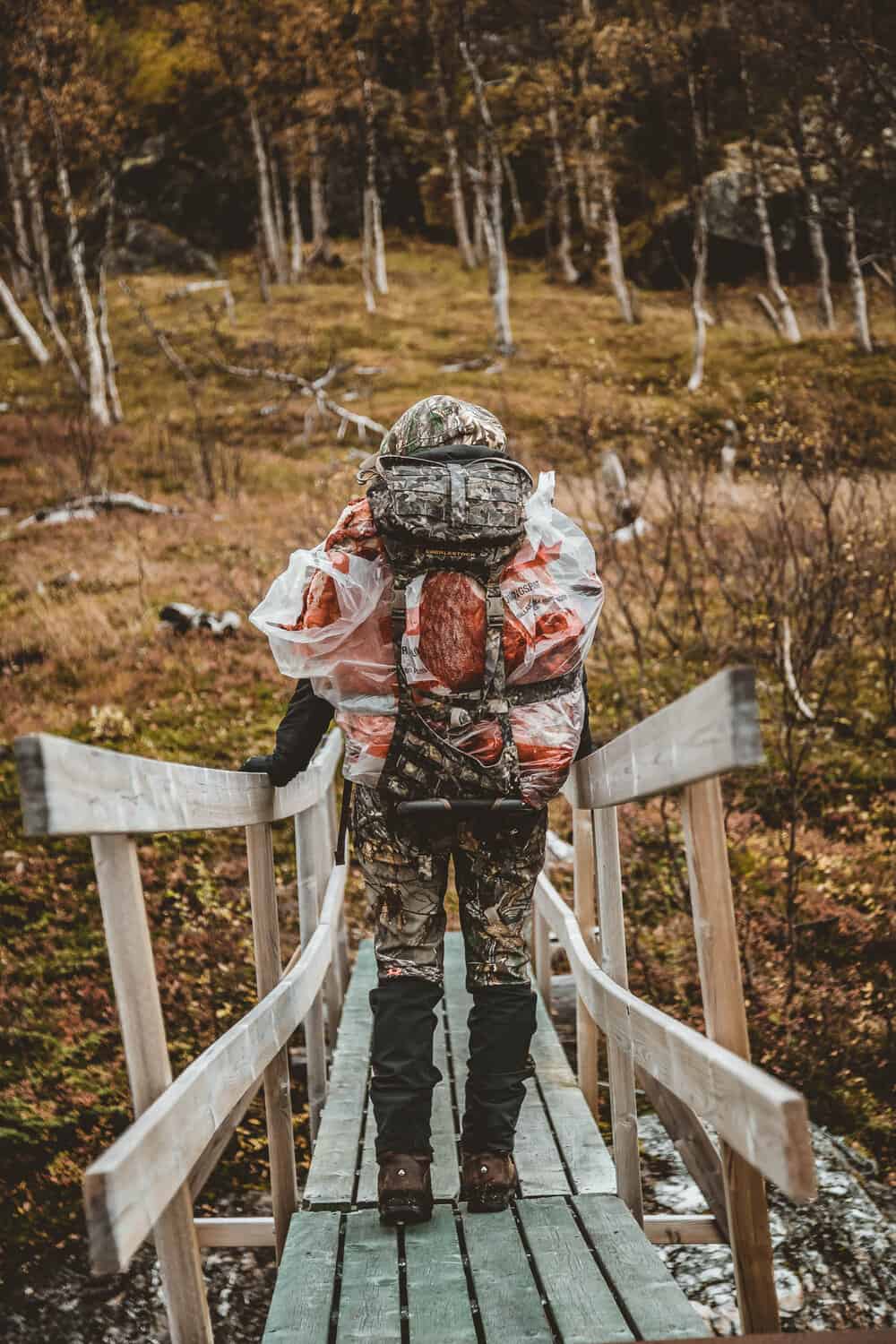
————————-
All hunters in Norway have to take an extensive two-part national hunting test. The first is an eight-day, one-off course on the ethics of hunting, gun safety, and species identification, followed by a written test. For the second part, each hunter must prove competency every year on the range, shooting at varying distances, with the final test requiring 5/5 shots in the heart of a reindeer target at 100 meters. Lise first took the test in high-school, as part of their outdoor education.